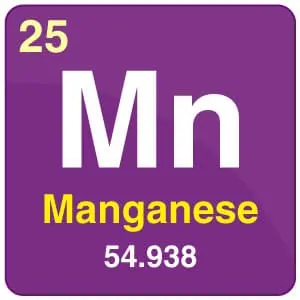Manganese
What is Manganese?
The chemical element manganese has the atomic number 25 and the symbol Mn. It is a silvery, hard, and brittle metal that is frequently found alongside iron in minerals.
In the 1770s, manganese was first separated. A transition metal, manganese is used in a wide range of industrial alloys, most notably stainless steel.
Strength, workability, and wear resistance are all enhanced. In addition to being utilized as a rubber component, manganese oxide finds use in the production of glass, fertilizers, and ceramics. You can use manganese sulfate as a fungicide.
In addition, manganese plays a crucial role in bone formation, the metabolism of macronutrients, and the body’s defensive mechanisms against free radicals.
It is an essential part of numerous proteins and enzymes. The brain, kidneys, liver, and bones are among the organs where it is primarily present.
In the human brain, manganese binds to manganese metalloproteins, primarily glutamine synthetase in astrocytes. In the laboratory, it is known as potassium permanganate or deep violet salt.
In certain enzymes, it takes place at the active sites. The role of a Mn-O cluster, the oxygen-evolving complex, in plants’ oxygen generation is particularly intriguing.
Characteristics
Physical Properties
Manganese is an iron-like metal with a silvery-gray color. It is quick to oxidize but difficult to fuse. It is hard and extremely brittle. The common ions of manganese metal exhibit paramagnetic behavior. In the air, manganese tarnishes slowly, and in water with dissolved oxygen, it oxidizes (“rusts”) like iron.
Isotopes
The single stable isotope of manganese found in nature is 55Mn. Numerous radioisotopes with atomic weights ranging from 46 u (46Mn) to 72 u (72Mn)have been identified and reported. With half-lives of 3.7 million years for 53Mn, 312.2 days for 54Mn, and 5.591 days for 52Mn, these are the most stable.
With the exception of a few, all of the remaining radioactive isotopes have half-lives of less than three hours or less than a minute.
For isotopes less than the most prevalent stable isotope, 55Mn, electron capture is the predominant decay mode; for heavier isotopes, beta decay is the predominant mode. Three meta-states exist for manganese as well.
As an element belonging to the iron group, manganese is assumed to have been created in massive stars just prior to the supernova explosion.
53Mn has a half-life of 3.7 million years before decaying to 53Cr. 53Mn, which is created when iron is impacted by cosmic rays, is relatively rare due to its short half-life.
Radiometric dating and isotope geology have made use of manganese isotopic contents, which are usually paired with chromium isotopic concentrations.
Isotopic ratios of Mn and Cr support the findings from the Solar System’s early history, 26Al and 107Pd are used. The initial 53Mn/55Mn ratio is suggested by variations in the 53Cr/52Cr and Mn/Cr ratios from a number of meteorites.
This means that the Mn–Cr isotope composition must be the product of 53Mn decaying in situ in differentiated planetary bodies.
Therefore, 53Mn offers more proof of nucleosynthetic activities occurring just prior to the Solar System’s coalescence.
Allotropes
Solid manganese exists in four recognized allotropes, or structural forms, denoted by the letters α, β, η, and δ, which appear at progressively greater temperatures. Although their atomic structures differ greatly, they are all metallic, stable at standard pressure, and have a cubic crystal lattice.
Alpha Manganese
The phase of equilibrium at normal temperature. It is unique among elemental metals in that it has an extremely complicated unit cell with 58 atoms per cell (compared to 29 atoms per primitive unit cell) in four different sorts of sites.
It also has a body-centered cubic lattice. At room temperature, it is paramagnetic; at temperatures below 95 K (−178 °C), it is antiferromagnetic.
Beta Manganese
When heated over the transition temperature of 973K (700 °C; 1,290 °F), (β-Mn) is formed. With 20 atoms per unit cell at two different sorts of sites, its primitive cubic structure is as complicated as any elemental metal’s.
By quickly quenching, it can be readily obtained as a metastable phase at room temperature. Up to the lowest temperature that has been measured (1.1 K), it remains paramagnetic and does not exhibit magnetic ordering.
Gamma Manganese
When heated over 1,370 K (1,100 °C; 2,010 °F), (γ-Mn) develops. With four atoms per unit cell, it has a straightforward face-centered cubic structure.
It turns into β-Mn when cooled to room temperature, but it can be stabilized thereby alloying it with at least 5% of other elements (such as C, Fe, Ni, Cu, Pd, or Au). These solute-stabilized alloys then exhibit a face-centered tetragonal structure in melting.
Delta Manganese
Above 1,406K (1,130 °C; 2,070 °F), (δ-Mn) is formed and remains stable until it reaches 1,519K (1,250 °C; 2,270 °F), the melting point of manganese. Its cubic structure is body-centered, with two atoms in each cubic unit cell.
Chemical Compounds
Manganese is commonly found in the oxidation states +2, +3, +4, +6, and +7, while all oxidation levels between -3 and +7 have been detected with the exception of -2.
The strongly purple permanganate anion MnO4− is represented by salts of manganese in its oxidation state +7.
Because of its oxidizing qualities, potassium permanganate is a frequently used laboratory reagent and is also used as a topical medication (for the treatment of fish ailments, for example).
One of the earliest stains and fixatives used to prepare biological cells and tissues for electron microscopy was potassium permanganate solutions.
Mn(VII) is represented by the volatile and unstable derivative Mn2O7, in addition to other permanganate salts. MnO3F and MnO3Cl, two oxyhalides, are potent oxidizers.
The green anion manganate, [MnO4]2-, is the most well-known example of manganese in the +6 oxidation state. In the process of removing manganese from its ores, manganate salts are used as intermediaries.
Somewhat elusive are compounds with oxidation states +5. One such example is the blue anion hypomanganate [MnO4]3-.
Seldom discovered compounds with Mn in the +5 oxidation state are frequently linked to an oxide (O2-) or nitride (N3-) ligand.
Because Mn(IV) is abundant in nature but much less prevalent in synthetic chemistry, it is a bit of a mystery.
MnO2 is the most prevalent form of Mn ore, pyrolusite. In addition to being a frequent component of dry cell batteries, it is the dark brown pigment found in many cave artwork.
Mn(IV) complexes are well-known, although complex ligands are needed for them. A number of enzymes, including the oxygen-evolving center (OEC) in plants, use Mn(IV)-OH complexes as an intermediary.
Basic derivatives Mn+3 are uncommon, although they can be stabilized with the right basic ligands. In organic synthesis, manganese(III) acetate is a helpful oxidant.
Manganese(III) solid compounds are distinguished by their intense purple-red hue and a predilection for deformed octahedral coordination as a result of the Jahn-Teller effect.
The light pink +2 oxidation state of manganese is one that occurs frequently in aqueous solution. There are several known manganese(II) compounds, including the aqua complexes made of manganese(II) chloride (MnCl2) and manganese(II) sulfate (MnSO4).
Rhodochrosite, or manganese(II) carbonate, is another mineral that exhibits this oxidation state. Because manganese(II) has a high pairing energy, it frequently occurs in a high spin ground state with S = 5/2. Manganese(II) has a pale tint because there are no spin-allowed d-d transitions in it.
Organomanganese Compounds
A wide range of organometallic derivatives, or molecules containing Mn-C bonds, are formed by manganese. Several instances of Mn in its lower oxidation states, namely Mn(-III) to Mn(I), are found in the organometallic compounds. The cheap cost and low toxicity of Mn make this field of organometallic chemistry appealing.”MMT” (methylcyclopentadienyl manganese tricarbonyl) is the compound of greatest economic importance. In certain countries, it is added to gasoline (petrol) as an anti-knock additive. It has Mn(I) in it.
Manganocene (Mn(C5H5)2) has a high spin, which is consistent with other aspects of Mn(II) chemistry. Conversely, ferrocene (Fe(C5H5)2), an air-stable, low-spin derivative, is formed by its surrounding metal iron.
Dimanganese is obtained from the reduction of Mn(II) salts in an environment containing carbon monoxide.Mn2(CO)10 decacarbonyl is a volatile, orange solid.
This Mn(0) compound’s (and its numerous derivatives’) strong electron-acceptor capabilities are demonstrated by their air stability. From Mn2(CO)10, several alkene and alkyne complexes are produced.
The low spin character of Mn(II) in Mn (CH3)2(dmpe)2 is in contrast to that of its predecessor, MnBr2(dmpe)2 (dmpe = (CH3)2PCH2CH2P(CH3)2).
Manganese compounds that are polyalkyl and polyaryl frequently have higher oxidation states, which is indicative of the ability of these ligands to release electrons. A case in point is [Mn(CH3)6]2-.
History
The name “manganese” has a complicated history. Two black minerals were recognized in antiquity from the Magnetes region (Magnesia, in modern Greece, or Magnesia ad Sipylum, in modern Turkey).
Despite being regarded as having different sexes, they were both referred to as magnes in their native country.
The word “magnet” most likely originated from the iron ore that the male magnes attracted, which is today known as magnetite or lodestone. Instead of drawing iron, the female magnes ore was used to discolor glass.
Later on, this female magnes was dubbed magnesia. presently recognized as manganese dioxide or pyrolusite in recent times. Magnetic properties are shared by elemental manganese and this mineral.
Glassmakers referred to manganese dioxide as manganese (note the two Ns instead of one) in the 16th century.
This may have been a corruption or concatenation of two words, as alchemists and glassmakers eventually had to distinguish between magnesia alba, a white ore from Magnesia that is also useful in glassmaking, and magnesia nigra, the black ore.
After being dubbed magnesia nigra manganese by Michele Mercati, the metal that was separated from it was eventually dubbed manganese (German: Mangan).
When the free element was isolated considerably later, the term “magnesia” was eventually limited to the white magnesia alba (magnesium oxide), which gave rise to the term “magnesium.”
The natural abundance of manganese dioxide has long been utilized as a pigment. MnO2 pigments in their crystalline state are used to create the 30,000–24,000-year-old cave paintings in Gargas.
Egyptian and Roman glassmakers employed manganese compounds to either enhance or diminish the color of their glass.
Venetian glass from the fourteenth century demonstrates how “glassmaker soap” was used, a practice that persisted into the modern era during the Middle Ages.
Manganese dioxide was available for experimentation by alchemists, the first chemists, since it was employed in glassmaking.
It was found by Johann Glauber (17th century) and Ignatius Gottfried Kaim (1770) that manganese dioxide could be transformed into permanganate, a helpful laboratory reagent.
It’s unclear if Kaim reduced manganese dioxide in order to separate the metal. The Manganese dioxide was utilized by Swedish chemist Carl Wilhelm Scheele in the middle of the 18th century to create chlorine.
Manganese dioxide was first created to react with hydrochloric acid or a solution of diluted sulfuric acid and sodium chloride.
Afterward, the Leblanc process hydrochloric acid was utilized, and the manganese dioxide was recycled using the Weldon process.
Manganese ores were extensively used in the manufacturing of bleaching chemicals such as hypochlorite and chlorine.
Pyrolusite, a crystalline form of manganese dioxide, contains a novel element that Scheele and others were aware of. In 1774, Johan Gottlieb Gahn used charcoal to reduce the dioxide in order to extract an impure sample of manganese metal.
There have been theories that Spartan steel is extraordinarily hard because of extra manganese added to the steel made from some iron ores used in Greece. Manganese was employed in the steel industry during the start of the 1800s, and multiple patents were issued.
It was reported in 1816 that iron alloyed with manganese was not more brittle, but rather harder. An early case of Parkinson’s disease was linked to heavy manganese exposure among miners, according to research done in 1837 by British scholar James Couper.
The application of manganese phosphate electrochemical conversion coatings to prevent rust and corrosion on firearms was first covered by US patents in 1912, and the method has been widely adopted ever since.
The demand for manganese dioxide increased with the development of batteries that used manganese dioxide as a cathodic depolarizer when the Leclanché cell was invented in 1866.
The majority of batteries included manganese until lithium and nickel-cadmium batteries were developed.
Naturally occurring manganese dioxide contains impurities, therefore the zinc-carbon battery and the alkaline battery typically employ industrially generated manganese dioxide instead.
Manganese dioxide was a common cathodic material for conventional (zinc-carbon) and alkaline commercial disposable dry batteries during the 20th century.
Occurrence
Manganese is the 12th most prevalent element in the crust, making up around 1000 ppm (0.1%) of the Earth’s crust.
Manganese levels in soil range from 7000–9000 ppm, with an average of 440 ppm. The amount in the atmosphere is 0.01 μg/m3.
Pyrolusite (MnO2), braunite (Mn2+Mn3+6)SiO12), psilomelane (Ba, H2O)2Mn5O10, and to a lesser extent, rhodochrosite (MnCO3) are the main forms of manganese found in the environment.3.Pyrolusite is the most significant manganese ore (MnO2).
Phalerite and other economically significant manganese ores typically exhibit close spatial relationships with iron ores.
Although abundant, land-based resources are dispersed erratically. Approximately 80% of the world’s known manganese resources are found in South Africa; significant manganese deposits can also be found in Brazil, Australia, China, Gabon, Ukraine, and India.
An estimate from 1978 states that there are 500 billion tons of manganese nodules on the ocean floor. In the 1970s, efforts to discover commercially feasible techniques for extracting manganese nodules were shelved.
With a 2011 estimate of 15 billion tons, the majority of South Africa’s known resources are in the Kalahari manganese fields, which lie near Hotazel in the Northern Cape Province.
South Africa produced more than any other country in 2011 with 3.4 million tons. The main manganese mining regions include South Africa, Australia, China, Gabon, Brazil, India, Kazakhstan, Ghana, Ukraine, and Malaysia.
Production
Manganese ore is combined with iron ore and carbon to produce ferromanganese, which is subsequently reduced in an electric arc furnace or blast furnace. Manganese concentration in the resulting ferromanganese ranges from 30 to 80%.
Manganese ore is leached with sulfuric acid, and then electrowinning is performed to generate pure manganese that is utilized to make alloys without iron.
Direct reduction of (a low-grade) manganese ore by heap leaching is a more advanced extraction method.
This is accomplished by allowing natural gas to seep through the bottom of the heap; the gas supplies both the reducing agent (carbon monoxide) and the heat (which must be at least 850 °C).
As a result, all of the manganese ore is reduced to the leachable form of manganese oxide (MnO). Then, the ore passes via a grinding circuit to reduce the ore’s particle size to 150–250 μm, increasing its surface area to help in leaching.
After that, the ore is put into a leach tank containing ferrous iron (Fe2+) and sulfuric acid in a 1.6:1 ratio.
Elements of manganese dioxide (MnO2) and iron combine to generate elemental manganese (Mn) and iron hydroxide (FeO(OH)).
About 92% of the manganese is recovered using this procedure. The manganese can then be transported to an electrowinning facility for additional purification.
Under the pretense of collecting manganese nodules from the ocean floor, the billionaire Howard Hughes, as part of the CIA’s Project Azorian, put the Hughes Glomar Explorer into service in 1972. This led to a frenzy of effort that wasn’t really necessary—collecting manganese nodules.
Hughes Glomar Explorer’s true purpose was to raise the K-129, a Soviet submarine that had been submerged, in order to retrieve Soviet code books.
Manganese nodules, which are found on the ocean floor, are a plentiful source of manganese. Research is being done on the possible effects of mining these nodules, which are situated along the ocean floor and contain 29% manganese.
Because of the disruption of the seafloor and the formation of sediment plumes brought on by this nodule mining, there may be physical, chemical, and biological environmental effects.
This suspension contains inorganic nutrients and metals that may cause dissolved hazardous chemicals to contaminate the near-bottom waters.
The Manganese Nodules serve as endo- and epifaunal systems’ grazing grounds, living quarters, and barriers. These systems are immediately impacted by the removal of these nodules.
Overall, this may lead to a species’ extinction or its complete eviction from the region. In an effort to completely comprehend the environmental effects and maybe mitigate them, state-sponsored enterprises and organizations connected to the UN are doing studies prior to the mining itself starting.
Oceanic Environment
Metal-rich hydrothermal particles from hydrothermal vents are the source of many trace elements found in the ocean. 90% of the dissolved manganese (dMn) found in the world’s seas comes from hydrothermal vents.
Over an active vent source, particulate Mn forms buoyant plumes, whereas dMn exhibits conservative behavior.
The concentrations of Mn differ among the ocean’s water columns. Due to input from outside sources including rivers, dust, and shelf sediments, dMn is raised at the surface.
The concentrations of Mn in coastal sediments are typically lower, but they can rise as a result of human-caused discharges from sectors like mining and steel production, which enter the ocean by river inputs.
Surface dMn Additionally, concentrations can rise physically due to coastal upwelling and wind-driven surface currents, as well as physiologically through photosynthesis.
By accelerating the dissolution of Mn-oxides and oxidative scavenging, internal cycling such as photo-reduction from UV light can also raise levels by preventing Mn from sinking into deeper waters.
Mid-ocean ridges and hydrothermal vents can be the location of elevated levels at mid-depths. Fluid high in dMn is released into the water through the hydrothermal vents.
Because the microbial capsules restrict interchange with particles, lowering the sinking rates, the dMn can thus travel up to 4,000 km.
When oxygen levels are low, the quantities of dissolved Mn are considerably higher. In general, dMn concentrations are often greater near the coast and lower offshore.
Soils
Three different oxidation states of manganese can be found in soils: the divalent cation Mn2+ as well as brownish-black Mn (III, IV) oxides and hydroxides, including MnOOH and MnO2. Which of these three forms of Mn is.
Predominant in a particular soil depends on factors such as pH and oxidation-reduction conditions. Mn(II) predominates at pH levels below 6 or in anaerobic settings; Mn(III, IV) oxides and hydroxides predominate in more alkaline and aerobic conditions.
Microbial activity can alter or regulate the impact of soil acidity and aeration conditions on the form of Mn.
Both the oxidation of Mn2+ to the oxides and the reduction of the oxides to the divalent cation are possible outcomes of microbial respiration.
The Mn(III, IV) oxides can be found on sand, silt, and clay particles as tiny nodules and brownish-black stains.
These high surface area, negatively charged surface coatings are present on other soil particles. Charged sites have the ability to absorb and hold onto a variety of cations, particularly heavy metals (such as Cr3+, Cu2+, Zn2+, and Pb2+).
Furthermore, the oxides have the ability to adsorb other substances and organic acids. The metals and organic molecules may then be oxidized as a result of their adsorption.
Whereas the Mn(III, IV) oxides (such as Cr3+ to Cr(VI) and colorless hydroquinone to tea-colored quinone polymers) are reduced to Mn2+.
Applications
There is no suitable equivalent for manganese in the majority of its metallurgical applications. Zinc and occasionally vanadium are suitable alternatives in small applications (like manganese phosphating).
Steel
The British metallurgist Robert Forester Mushet (1811–1891) first recognized the importance of manganese in the production of iron and steel.
In 1856, he introduced the element, Spiegeleisen, into steel with the express intent of eliminating excess dissolved oxygen, sulfur, and phosphorus to improve the steel’s malleability.
Approximately 85% to 90% of the global manganese demand is currently met by steelmaking, which includes the ironmaking component.
An essential ingredient in inexpensive stainless steel is manganese. In most modern procedures, the intermediate is frequently ferromanganese, which is typically about 80% manganese.
Tiny amounts of manganese inhibit the production of a liquid iron sulfide at the grain boundaries and instead create a high-melting sulfide that makes steel more workable at high temperatures.
The embrittlement of the steel takes center stage when the manganese concentration hits 4%. Higher manganese concentrations cause the embrittlement to diminish; at 8%, it reaches a tolerable level.
Steel with 8 to 15% manganese content can withstand loads of up to 863 MPa. Robert Hadfield discovered steel with 12% manganese in 1882; this steel is now referred to as Hadfield steel (mangalloy). The British military employed it for steel helmets, and the US military eventually adopted it.
Aluminium Alloys
In order to produce alloys containing aluminum, manganese is needed. Because the grains in aluminum with around 1.5% manganese absorb impurities that would cause galvanic corrosion, the metal is more resistant to corrosion.
Most beverage cans are made of corrosion-resistant aluminum alloys 3004 and 3104 (0.8 to 1.5% manganese). These alloys were employed in more than 1.6 million tonnes of work before 2000; at 1% manganese, that equates to 16,000 tonnes of manganese.
Batteries
Manganese(IV) oxide, the blackish substance found in carbon-zinc type flashlight cells, was utilized as an electron acceptor from zinc in the first dry cell battery design.
During discharging, the manganese dioxide is reduced to the manganese oxide-hydroxide MnO(OH), which stops hydrogen from forming at the battery’s anode.
MnO2 + H2O + e− → MnO(OH) + OH−
Modern alkaline batteries (often battery cells) that use a different electrolyte mixture but the same basic reaction also use the same substance. For this reason, around 230,000 tons of manganese dioxide were used in 2002.
Resistors
Manganese copper alloys, such as Manganin, are frequently found in metal element shunt resistors, which are used to measure quite high current levels. These alloys are resistant to sulfur and have a very low-temperature coefficient of resistance. Because of this, the alloys are especially beneficial in abrasive industrial and automotive settings.
Fertilizers and Feed Additive
Fertilizers include both sulfate and manganese oxide. An estimated 20,000 tons of these chemicals were utilized in fertilizers in the United States alone in 2000. Animal meals also included similar amounts of Mn compounds.
Niche
Certain unleaded gasoline contains an ingredient called methylcyclopentadienyl manganese tricarbonyl, which raises the octane rating and lowers engine knocking.
In organic chemistry, manganese(IV) oxide, also known as manganese dioxide or MnO2, is used as a reagent to oxidize benzylic alcohols, which are compounds in which the hydroxyl group is next to an aromatic ring.
Since ancient times, glass that has had traces of iron pollution has had a greenish tint that can be neutralized and oxidized using manganese dioxide.MnO2 is also utilized in the drying of black paints and in the production of chlorine and oxygen.
It is a component of natural number and a brown paint pigment in some preparations. Tetravalent manganese is employed in red-emitting phosphors as an activator.
Although there are numerous chemicals that exhibit luminescence, most of them are not employed in commercial settings because of their low efficiency or strong red emission.
Nonetheless, a number of fluorides triggered by Mn4+ have been suggested as possible red-emitting phosphors for warm-white LEDs. But as of right now, the only commercially available material for usage in warm-white LEDs is K2SiF6Mn4+.
The “wartime” nickel, which was made from 1942 to 1945, was the only American coin to include manganese until 2000.
The metal is occasionally used in coins. Nickel coins were historically made of an alloy consisting of 25% nickel and 75% copper. However, due to a lack of nickel metal during the war, more readily accessible silver and manganese were used in its place, resulting in an alloy that is 35% silver, 9% manganese, and 56% copper.
From the year 2000, Sacagawea dollar and Presidential $1 coins, for instance, are composed of brass with a pure copper core and 7% manganese content.
Manganese was used in the nickel and dollar coins to mimic the electromagnetic characteristics of a prior coin of the same size and value in the vending machine mechanics.
The manganese alloy used in the later U.S. dollar coins was designed to mimic the characteristics of the copper/nickel alloy used in the earlier Manganese compounds that have been used to color glass and ceramics as well as pigments.
Manganese compounds can sometimes give ceramics a brown hue. Manganese compounds have two uses in the glass industry.
By producing less-colored iron (III) and slightly pink manganese (II), manganese (III) combines with iron (II) to lessen the strong green color in the glass and balance out the residual color of the iron (III). More manganese is needed to make glass that is pink in color.
Manganese can be mixed with yttrium and indium to create YInMn blue, a brilliantly blue, non-toxic, fade-resistant pigment that was discovered in 2009 by Professor Mas Subramanian and colleagues at Oregon State University. This is the first new blue pigment to be identified in 200 years.
Biochemistry
Manganese cofactors are found in a wide range of enzyme classes, such as ligases, oxidoreductases, transferases, hydrolases, lyases, and isomerases.
Arginase and a Mn-containing superoxide dismutase (Mn-SOD) are two other manganese-containing enzymes. Manganese is present in some reverse transcriptases of numerous retroviruses, but not lentiviruses like HIV.
The lectins, integrins, and diphtheria toxins are polypeptides that include manganese.OEC, which is composed of four manganese atoms, is a component of photosystem II found in the thylakoid membranes of chloroplasts.
The OEC is the catalyst that creates the O2 that plants produce throughout the light reactions of photosynthesis, which includes the terminal photooxidation of water.
Human Health and Nutrition
Manganese is a necessary food component for humans. It functions as a coenzyme in a number of biological processes, such as the metabolism of macronutrients, the development of bone, and the defense mechanisms against free radicals.
It is an essential part of numerous proteins and enzymes. Manganese, which is largely found in bones, makes up around 12 mg of the human body. The liver and kidneys contain the majority of the remaining soft tissue.
In the human brain, manganese binds to manganese metalloproteins, primarily glutamine synthetase in astrocytes.
Regulation
The Recommended Dietary Allowances (RDAs) and Estimated Average Requirements (EARs) for minerals were revised by the U.S. Institute of Medicine (IOM) in 2001.
Since there was insufficient data to establish EARs and RDAs for manganese, demands are expressed as estimates for Adequate Intakes (AIs).
Acceptable upper intake limits (ULs) for vitamins and minerals are set by the IOM when there is sufficient evidence to support a particular claim. The adult upper limit of manganese is 11 mg/day.
The combined EARs, RDAs, AIs, and ULs are referred to as Dietary Reference Intakes (DRIs). Rarely occurs manganese insufficiency.
The European Food Safety Authority (EFSA) refers to the combined set of data as Dietary Reference Values, and instead of using RDA and Average, it uses Population Reference Intake (PRI).Requirement (EAR) in place of EAR.
AI and UL have the same meanings as they have in the US. The AI dosage for those above the age of 15 is 3.0 mg/day. 3.0 mg/day of AIs is recommended for lactation and pregnancy. The amount of AIs increases with age in children aged 1 to 14 years, from 0.5 to 2.0 mg/day.
The adult AIs exceed the RDAs in the United States. After reviewing the same safety concern, the EFSA determined that not enough data was available to establish a UL.
To comply with U.S. laws governing the labeling of foods and dietary supplements, the amount in a serving is expressed as a percentage of the Daily Value (%DV).
100% of the Daily Value for manganese labeling was 2.0 mg; however, starting on May 27, 2016, it was changed to 2.3 mg to conform to the RDA.
The previous and new adult daily values are listed in a table atManganism is a neurodegenerative ailment that involves dopaminergic neuronal death and symptoms resembling Parkinson’s disease. It can be brought on by excessive exposure or consumption.
Deficiency
An unusual deficit of manganese in humans leads to several medical issues. Animals with manganese deficiencies have deformed skeletons, and their inability to produce collagen during wound healing is another effect.
Exposure
In Water
Compared to dietary manganese, manganese in water has a higher bioavailability. A 2010 study found that children of school age who are exposed to higher levels of manganese in their drinking water have lower cognitive quotients and greater intellectual impairment.
Long-term exposure to the naturally occurring manganese found in shower water is thought to pose a risk to up to 8.7 million Americans.
Data suggests that, if manganese exposure is halted and the body is able to eliminate the excess, it is possible for the human body to recover from some negative consequences of excessive manganese exposure.
When hypoxic periods happen, seawater’s Mn levels may rise. Reports of Mn buildup in marine animals, such as fish, crabs, mollusks, and echinoderms, date back to 1990.
Different species target different tissues, such as the brain, blood, kidney, liver/hepatopancreas, and gills. There have been reports of physiological impacts on these animals.
Mn can have an impact on immunocytes’ ability to renew and function, including phagocytosis and pro-phenoloxidase activation, which can decrease an organism’s immune system.
As a result, the organisms become more vulnerable to infections. Pathogen distributions spread more widely due to climate change, and organisms require robust immune systems to both survive and fight off these pathogens.
They will be dead if their systems are damaged by excessive Mn levels and they are unable to fight off these infections.
Gasoline
Methylcyclopentadienyl manganese tricarbonyl, or MMT, is an additive designed to raise the octane rating of gasoline by substituting lead compounds. MMT is only utilized in a few nations. Manganese-containing fuels frequently produce manganese carbides, which corrode exhaust valves.
Air
The amount of manganese in the air has decreased since 1953. Mn-induced symptoms are generally caused by exposure to ambient Mn air values greater than 5 μg Mn/m3.
In human embryonic kidney (HEK293) cells, increased ferroportin protein expression is linked to lower intracellular Mn content and reduced cytotoxicity, which is manifested as reduced lactate dehydrogenase leakage and reversed glutamate uptake due to Mn.
Regulation
In the US, the Occupational Safety and Health Administration (OSHA) controls exposure to manganese. Manganese can enter a person’s respiratory system or be swallowed at work.
OSHA has established 5mg/m3 as the legal limit (permissible exposure limit) for workplace manganese exposure during an 8-hour workday.
A short-term limit of 3mg/m3 and a recommended exposure limit (REL) of 1 mg/m3 for an 8-hour workday have been established by the National Institute for Occupational Safety and Health (NIOSH). Manganese poses an urgent risk to life and health at 500 mg/m3.
Health and Safety
Even though it comes in milligram levels, manganese is necessary for human health.
According to US EPA regulations, the current maximum acceptable quantity is 50 μg Mn/L.
Manganism
Manganism, a rare neurological condition linked to excessive manganese consumption or inhalation, is most commonly linked to manganese overexposure.
Manganism has historically been a risk for anyone working in the processing or manufacturing of manganese alloys, but in industrialized countries, workers are protected by health and safety laws.
British scholar John Couper originally described the illness in 1837 after studying two patients who ground manganese. Manganism is a condition with two phases.
An individual under the influence of alcohol may initially exhibit psychosis, obsessive behaviors, mood swings, and depression. Early-stage neurological symptoms give place to Parkinson-like late-stage manganism.
Weakness, slow, monotone speech, tremors, tremor-forward gait, inability to walk backward without falling, stiffness, and general issues with dexterity, gait, and balance are among the symptoms.
Manganism is not linked to olfactory loss, in contrast to Parkinson’s disease, and its sufferers usually do not respond well to L-DOPA treatment.
Over time, even if the source of exposure is eliminated and brain manganese levels return to normal, the symptoms of late-stage manganism worsen.
It has been demonstrated that long-term manganese exposure causes a Parkinsonian-like disease with aberrant movement patterns.
Since this illness does not respond to standard PD treatments, there may be a different mechanism at work in the substantia nigra than the usual dopaminergic depletion.
The aberrant motions may be caused by an accumulation of manganese in the basal ganglia. This Parkinsonism-like condition has been associated with a mutation of the SLC30A10 gene, which is a manganese efflux transporter required for reducing intracellular Mn.
In parkinsonism caused by Mn, there are no Lewy bodies like in PD. It has been possible to study the effects of manganese overexposure in controlled settings thanks to animal trials. Manganese causes rats to kill mice in a non-aggressive manner.
Toxicity
Comparatively speaking, manganese compounds are less hazardous than those of other common metals like nickel and copper.
However, due to manganese’s high level of toxicity, even brief exposure to dust and fumes should not exceed the ceiling value of 5 mg/m3. Cognitive problems and decreased motor abilities have been related to manganese toxicity.
Neurodegenerative Diseases
Manganese is primarily absorbed from the gut by a protein known as DMT1, which also has the potential to be the main manganese transporter across the blood–brain barrier.
Inhaled manganese is also transported across the nasal epithelium via DMT1. Manganese toxicity is thought to be caused by dysregulation, which can result in protein aggregation, glutamate-mediated excitotoxicity, oxidative stress, and mitochondrial dysfunction.
FAQ
What is manganese used for?
Steel and other alloys are the main applications for it. About 1% of steel is manganese-infused to improve workability, wear resistance, and strength. About 13% of manganese is present in manganese steel. This is utilized for prison bars, safes, rifle barrels, and railroad tracks since it is incredibly robust.
How is manganese used every day?
Manganese is used by your body to produce energy and shield your cells from harm. Manganese is also necessary for healthy blood coagulation, strong bones, reproduction, and the immune system.
Who found manganese?
The pronunciation of manganese is MAN-ge-nees. Background and Applications: Later that year, Swedish scientist Johan Gottlieb Gahn discovered manganese, which Carl Wilhelm Scheele had proposed as an element in 1774. Gahn did this by heating the mineral pyrolusite (MnO2) in the presence of charcoal.
Which food has manganese?
other foods, such as whole grains, clams, oysters, mussels, almonds, soybeans and other legumes, rice, green vegetables, coffee, tea, and other spices, such as black pepper, contain manganese [1, 2, 5, 10, 11]. Manganese is also present in trace levels in drinking water, ranging from 1 to 100 mcg/L.
Where is manganese found?
Nowadays, ores from Brazil, Australia, South Africa, Gabon, India, and Russia provide the majority of the world’s manganese. Rhodochrosite and pyroclusite are two of the most prevalent manganese minerals. Either electrolysis or reduction of the oxide with sodium, magnesium, or aluminum yields the metal.
How is manganese made?
Hydrometallurgical and electrolytic procedures are used to create pure manganese, whereas a blast furnace or, more frequently, an electric furnace is used to smelt ores to make ferromanganese and silicomanganese.
Can you drink manganese?
Manganese is necessary for human health in modest amounts. However, a recent study from Health Canada indicates that consuming too much manganese in water may be harmful to your health. Manganese has no flavor, however it can discolor.







